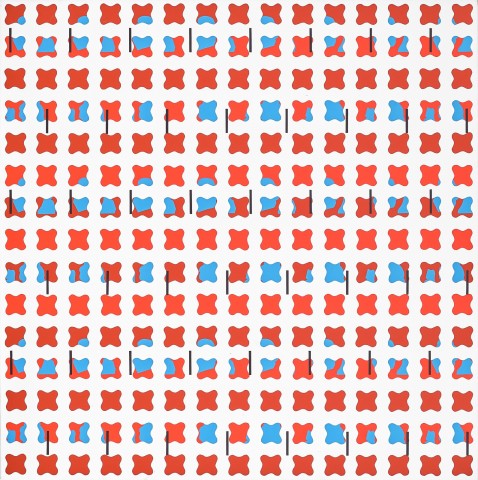CANINE CAPERS VII, 1969 – 79
ROBERT ROONEY
synthetic polymer paint on canvas
153.0 x 153.0 cm
signed, dated and inscribed with title verso: Robert Rooney / … / CANINE CAPERS VII 1969 – 79
Estate of the artist, Melbourne
Canine Capers III, 1969, synthetic polymer paint on canvas, 152.4 x 152.4 cm, in the collection of the Art Gallery of New South Wales, Sydney
Canine Capers IV, 1969, synthetic polymer paint on canvas, 152.0 x 152.0 cm, in the collection of the Art Gallery of South Australia, Adelaide
Despite his widespread influence as not only one of Australia’s most innovative exponents of conceptual and pop art, but as a renowned art critic for two broadsheet newspapers over two decades as well,1 remarkably Robert Rooney spent almost his entire life living in the city of Melbourne. Born in 1937, he studied art with Dale Hickey at Swinburne Technical College from 1954-57, and subsequently at the Phillip Institute in Preston from 1972 – 73. Notwithstanding his reluctance to venture beyond his hometown, throughout his career Rooney remained obsessively informed of global contemporary art activity and cultural phenomena – amassing a formidable collection of magazines, art books, photographic prints and newspaper clippings. He also forged correspondence with various artists abroad, including, most famously, his seven-year exchange with New York-based conceptualist, Roger Cutforth. During his formative years Rooney experimented with colours and shapes of mass-produced domestic objects to create geometric, hard-edge abstractions and in 1968, gained international recognition with his inclusion in the seminal survey of colour-field painting, The Field, organised by the National Gallery of Victoria. From 1969 to 1981, Rooney’s practice however became more conceptualist and process-based, exploring ideas of duration, routine and repetition through serial photography. He eventually returned to painting in 1982, appropriating both printed ephemera and his own earlier oeuvre to interrogate the potential for ‘absenting content’ in a manner reminiscent of Pop pioneers, Warhol and Duchamp. Significantly, in 1982 Rooney was included in Paul Taylor’s controversial exhibition of Post-Pop art, POPISM, at the National Gallery of Victoria; and more recently, in 2010 his contribution was honoured with Endless Present: Robert Rooney and Conceptual Art at the National Gallery of Victoria.
Quintessentially Pop with its motifs of domesticity, suburbanism and repetition, the ‘Canine Capers’ series – exemplified superbly here by Canine Capers, no.7, 1968 – was significantly produced the same year as the groundbreaking Field show, and remains acclaimed among Rooney’s finest achievements with other examples housed in the Art Gallery of New South Wales and the Art Gallery of South Australia. Created from stencils inspired by the pre-designed animal shapes on the back of Kellogg’s Corn Flakes packets (intended to be cut out by children and assembled as mobiles), the series cunningly collides abstraction and representation, flirting mimesis while disavowing reference. If a Duchampian pun is also discernible in the play between ‘cereal’ and ‘serial’, the supreme irony, as Philip Brophy suggests, ‘is to be found in the innate abstractiveness of the cereal box shapes, marking Rooney’s works as even more hard-edged than ‘the real thing’…’2 Like the two series preceding ‘Canine Capers’ – namely, Kind-Hearted Kitchen Garden, Nos.1-4, and Slippery Seals, Nos. 1-5, both of 1966, here Rooney invokes the device of the interlocking meta-grid, comprised of a repeated motif aligned vertically and horizontally, to structurally reinforce the relationship between the cut-out commodity and the fine art object. Viewed as a consecutive series with each successive painting slightly altering the angle of either all or some of the motifs in alternate sequence, thus a complex polyphonic play of rhythms, shapes and their interlocking grids is achieved – almost akin to a cinematic animation.3 Concerned more with the conceptualisation of perception involved in defining hard-edge abstraction than the practical methods of its production, indeed Canine Capers VII eloquently attests to Rooney’s strong neo-conceptual approach – already evident in these early investigations – that is today considered his greatest legacy.
1. Rooney worked at The Age from 1980 – 82, and at The Australian from 1982 – 99.
2. Brophy, P., ‘Robert Rooney as Pop’ in From the Homefront – Robert Rooney Works 1953 – 1988, exhibition catalogue, Monash University of Art, Melbourne, 1990
3. ibid.
VERONICA ANGELATOS
